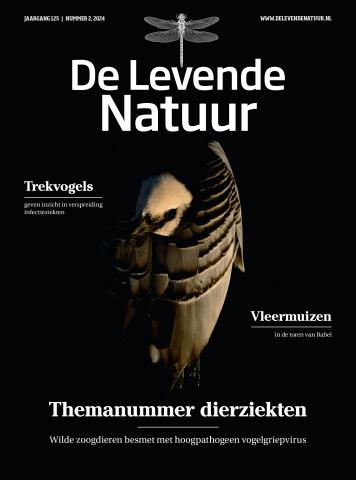De Levende Natuur nummer 2 van 2024 (English summary)
Thema
Afbeelding

One earth, one health
The ongoing outbreak of the highly pathogenic avian influenza H5N1, but also the outbreak of COVID-19 and other zoonotic diseases prove: the human world with its livestock, and the natural world are highly entwined. In his guest editorial, professor of virology Thijs Kuiken argues that we desperately need a ‘One Health approach’, to improve conditions for animals, ecosystems and humans alike.
Migrating bird provide insights into spreading diseases
Billions of birds travel across the globe each year and can transport zoonotic pathogens during their annual migrations between breeding and wintering sites. However, the probability that they will actually do so is low, and depends on many factors. Quantifying the role of wild birds in the introduction of zoonotic diseases in novel areas involves long-term monitoring at a large scale. Volunteer bird ringers sample thousands of birds in the Netherlands each year, providing early-warning signals for diseases like usutu virus (2016), and the more dangerous westnile virus (2020). By putting results from various national sampling schemes together, phylogenetic evidence for repeated introductions from Africa into Europe and vice versa has now accumulated. Likewise, the involvement of long-distance migrating ducks in the transport of highly pathogenic avian influenza between continents has been illustrated using a combination of sampling, ringing and tracking data. Apart from vectors, birds are also victims and recently, millions of birds have died from the novel, deadly strains, and it may take years before their populations recover.
Mammals infected with H5N1 virus
Highly pathogenic avian influenza A (H5N1) virus recently caused disease and mortality in wild birds and poultry in the Netherlands, but also (fatal) infection in at least 40 wild mammals of 7 different species (period 2020-2022). Research showed that the virus could change in the mammal hosts and show mutations consistent with adaptation to mammals. However, there was no evidence for mammal-to-mammal transmission of virus in the Netherlands. It is important to keep monitoring wildlife for early detection of highly pathogenic avian influenza A (H5N1) virus infections in mammals.
Utsu-virus continues to roam
This article describes Usutu-virus in general, and in specific the development of Usutu-virus in the Netherlands. Information is given about signs in blackbirds due to infection with Usutu-virus. It explains why the disease is a summerdisease and which birdspecies were detected in dead wild birds. Also information about the blackbird population is presented.
Can we prevent the spreading of avian influenza among wild birds?
Since 2016, highly pathogenic avian influenza (HPAI) viruses have caused regular mass mortality events among wild birds in the Netherlands. With more species affected, the call for solutions is becoming louder. Can we do anything? Recent experiences tell us that we can, although the effectiveness of measures is generally unclear. Measures can be grouped into prevention, mitigation and avoiding long-term consequences. Avoiding transmission is the key to prevention. Providing a HPAI free environment at breeding colonies by removing carcasses early in the season and strict biosecurity protocols for field workers may help. During an outbreak, regular carcass removal is often recommended, although there are risks associated with entering colonies. Other mitigation measures include compartmenting breeding colonies to restrict chick movements and preventing access by the public to avoid disturbance. Longer-term effects can be reduced also by removing carcasses, which may remain infective for months and can be a source of botulism. The recovery of affected populations may be stimulated by targeted conservation measures. Finally, spill-over to humans must be avoided by allowing only professionals to handle infected birds and informing the public about the risks. HPAI outbreaks among wild birds will likely occur regularly over the coming years and a strategic preparedness plan, stating the necessary actions and responsibilities, is strongly recommended.
Trichomonosis infects wild birds
Trichomonosis has been known to cause disease and mortality in wild birds for decades. Doves and raptors that often prey on doves, were regarded as the most vulnerable species. In captive species the disease has also been reported in e.g. parakeets and finches. In 2005, a strain of Trichomonosis was identified in Britain that caused high rates of mortality in European Greenfinches and Common Chaffinches. It did not take long before similar reports emerged elsewhere in Europe. The impact was so great that it even led to significant population declines. In Britain, the number of European Greenfinches and Common Chaffinches decreased with approximately 67% and 29% respectively in 2008-2018. Also in the Netherlands, trends of Common Greenfinch are now showing declines. Supplementary feeding of garden birds may have played an important role in the emergence of the disease, but more research is needed to understand the mechanisms. Meanwhile, it is recommended to clean drinking and feeding stations daily, allow them to dry thoroughly and to move them regularly, or to temporarily stop feeding when sick birds are present.
Bats in the Tower of Babel
‘Bats' are frequently blamed when it comes to the spread of viruses. Biologically speaking, a substantial amount of research shows, there is no good reason for this blaming. Therefore, there seems to be an important task for communication experts to get the right message across.
Recognizing the ranavirus
Considering that ranavirus is an emerging infectious disease that can occur in a wide variety of amphibians and can also spread rapidly over long distances, preventing it is very important. One third of all amphibians worldwide are threatened with extinction. Infectious diseases are also contributing to this. Endangered species such as the garlic toad, midwife toad and fire salamander might face problems due to the ranavirus. Amphibian communities abroad, such as Spain, have already collapsed. To prevent this in the Netherlands, recognizing any symptoms and reporting them to RAVON is important.


